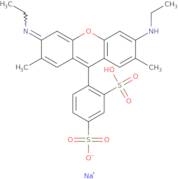Sulfordamine G
CAS: 5873-16-5
Ref. 3D-FS76162
| 1g | Descontinuado | ||
| 2g | Descontinuado | ||
| 5g | Descontinuado | ||
| 10g | Descontinuado | ||
| 25g | Descontinuado | ||
| 50g | Descontinuado | ||
| 100g | Descontinuado | ||
| 250g | Descontinuado | ||
| 500mg | Descontinuado |
Informação sobre produto
- Acid Red 50
- Acid Rhodamine G
- Amido Rhodamine G
- Brilliant Superlan Rhodamine GLBH
- C-WR Red 16
- Lissamine Rhodamine G
- Lissamine Rhodamine GP
- Lissamine Rhodamine GS
- Sulforhodamine G Extra
- Triacid Rhodamine G
- Ver mais sinónimos
- Xanthylium, 9-(2,4-disulfophenyl)-3,6-bis(ethylamino)-2,7-dimethyl-, hydroxide, inner salt, monosodium salt
- Xanthylium, 9-(2,4-disulfophenyl)-3,6-bis(ethylamino)-2,7-dimethyl-, inner salt, monosodium salt
- Xanthylium, 9-(2,4-disulfophenyl)-3,6-bis(ethylamino)-2,7-dimethyl-, inner salt, sodium salt (1:1)
- m-Benzenedisulfonic acid, 4-[6-(ethylamino)-3-(ethylimino)-2,7-dimethyl-3H-xanthen-9-yl]-, monosodium salt
- sodium 4-[(3E)-6-(ethylamino)-3-(ethyliminio)-2,7-dimethyl-3H-xanthen-9-yl]benzene-1,3-disulfonate
Sulfordamine G is a synthetic polymer that forms a hydroxide solution with water. The polymer film has been shown to be fluorescent in the presence of hydrogen peroxide and can be used as an indicator for hydrogen peroxide, acting as a replacement for the more expensive and dangerous luminol. Sulfordamine G has also been shown to have an adsorption mechanism that allows it to bind to damaged DNA. This compound is able to form hydrogen bonds with other molecules and has been shown to be effective in cell culture experiments. It has also been used in optical sensor systems for monitoring reactions, such as enzymatic reactions, due to its fluorescence properties.





